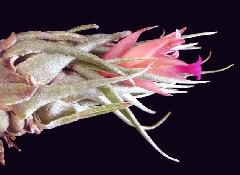


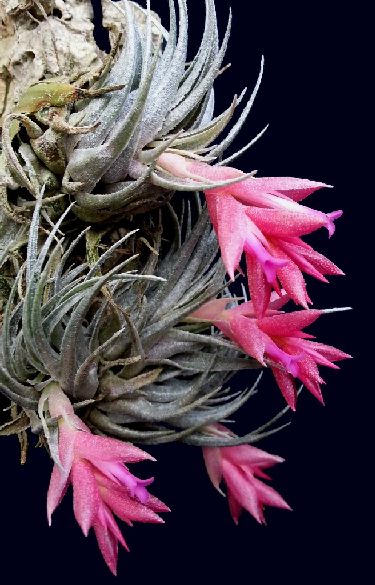
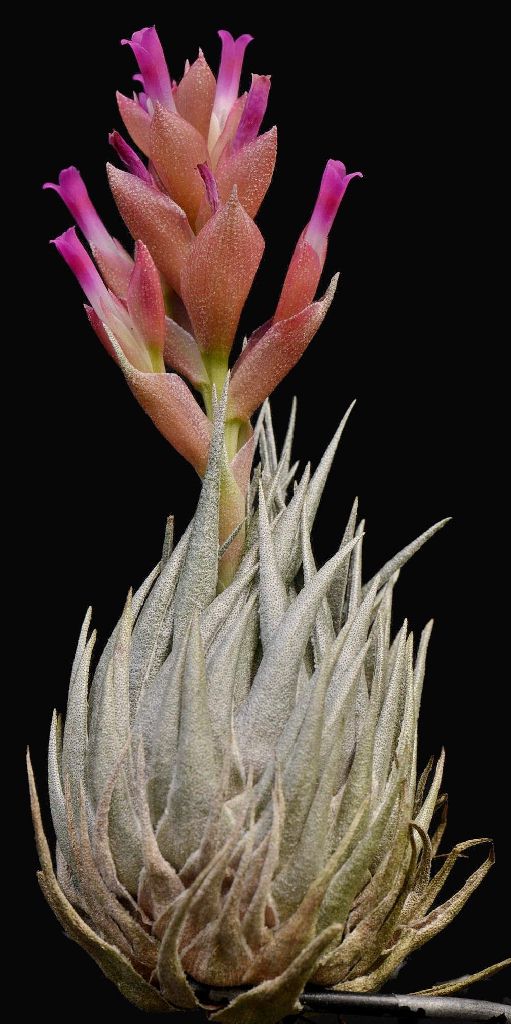
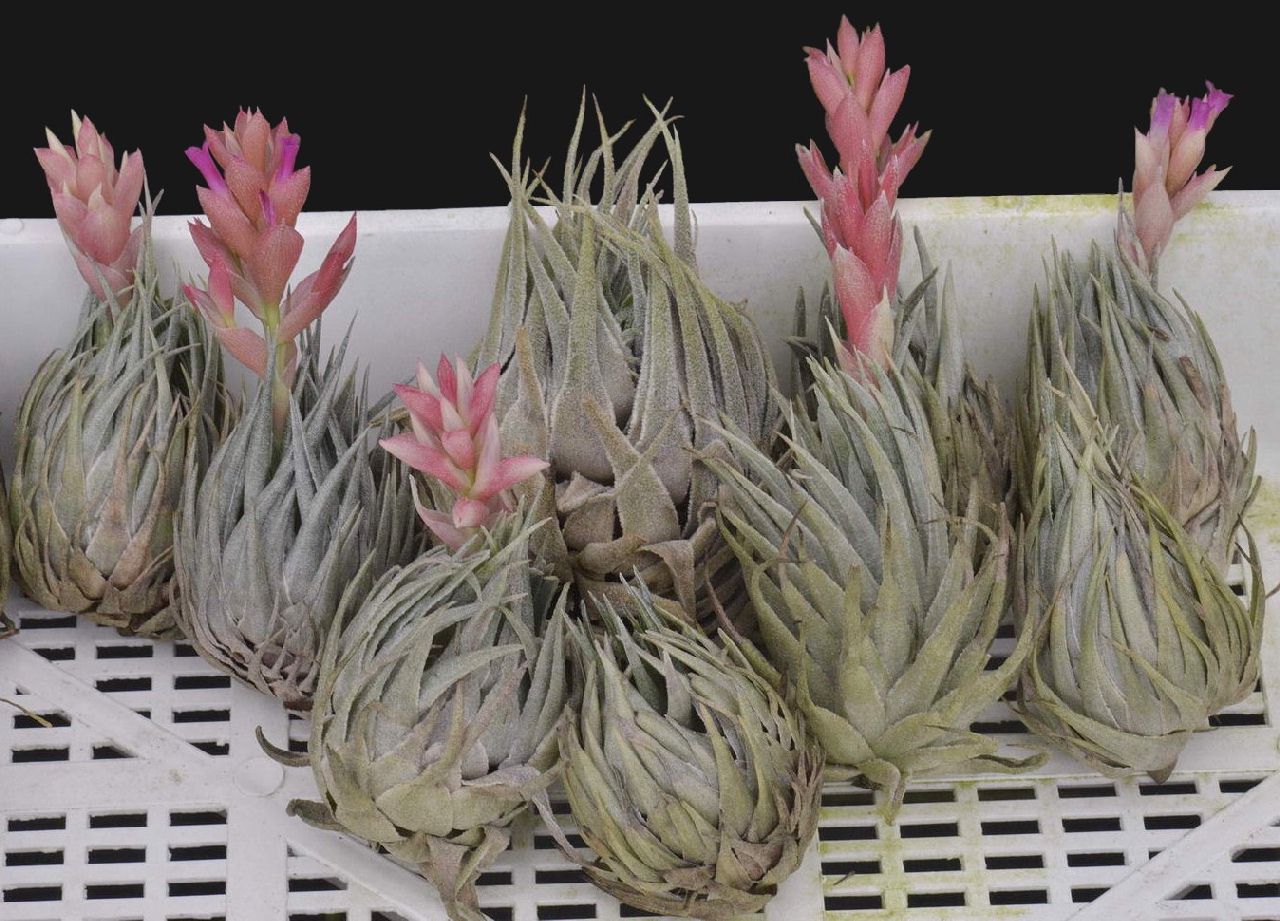

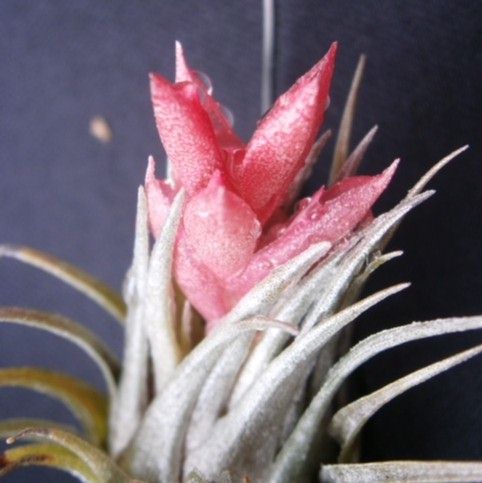




Tillandsia kautskyi E Pereira, Bradea 1; 438, pl.2 1974
Descr from CITES March 2013 when T. kautskyi was removed from CITES
Plants with flowers 8-8.5 cm in height, single or forming clusters, heliophilous epiphyte, mesophytic.
Roots present in the adult plant.
Rhizome short, 4-10 cm long, simple, without lateral stems.
Leaves 50-60, approx. 4-6 cm long, densely imbricate, generally curved; base of the leaf 0.8 to 1.4 cm wide, elliptical, slightly caniculate, fleshy, densely lepidote, asymmetrical absorbent trichomes, covering the edge of the leaf.
Main stems 2.5-6 cm long, equivalent to the size of the rosette leaf, delicate, slightly curved, glabrous;
bracts of the main stem 3-4, upper ones 0.2 cm long, lower ones 3 cm long, non-laminar, larger than the joints, imbricate, elliptical, pink in colour.
Paniculate inflorcscence 4 cm long, 3 cm in diameter, 4-12 branches, with 24 flowers, erect or slightly spreading.
Floral bracts 0.8 to 1.5cm long, extending beyond the sepals, 0.6 to 1.2cm wide, elliptical, pointed, carinate, membranous, pinkish or reddish, densely lepidote.
Flowers 1.8-2cm long, sessile;
Sepals 0.9 to 1.5cm long, 0.3cm wide, lanceolate, acuminate, free ends, scarcely lepidote, not carinate, but bearing the greenish or pinkish central nerve.
Petals 1.6 to 2.2cm long, 0.25 to 0.30cm wide, elliptical, unbroken edge, blunt, reflexed at anthesis, forming an open corolla, upper part carmine red or dark red, part towards the base white.
Stamens 1.5 to 1.8cm long, almost matching the total length of the petals, included, filaments 1.3 to 1.5 cm long, flat, straight or slightly protruding under the anthera, white, antheras 0.2 cm long, 0.03 cm wide, linear, dorsifixed, not versatile, yellowish-brown in colour.
Ovary 0.3 cm long, 0.2 cm in diameter, oval, style 0.8-1 cm long, white, red towards the apex, stigma 0.1 cm long, trilobate, simple, erect.
Desc from Ehlers in Die Bromelie Sonderheft 3, 1996
Plant single or growing in small groups epiphytically, stemless, flowering 4-10 cm high, 3-8 cm in diameter, 20-30 leaves forming an erect, mostly secund, subbulbose rosette.
Leaves: up to 9 cm long, polystichous, densely imbricate, bent and often distinctly secund, soft grey green, densely appressed lepidote, never pruinose, metallic grey green or resembling silvery.
Sheath 8-14 mm wide, elliptic-triangular, slightly distinct.
Blade 3-7 cm long, 8-13 mm wide, narrow triangular attenuate, secund, almost flat to slightly canaliculate, with densely appressed white trichomes.
Scape: 2.5-6 cm long, as long as the leaf rosette, slender, almost erect to recurved, glabrous, covered by 3-4 imbricate, elliptic, long attenuate, pink scape bracts. Inflorescence: exceeding the rosette, up to 4 cm long, up to 3 cm in diameter, elliptic, densely polystichous, simple or bipinnate at base with 4-12 erect or a little spreading branches.
Primary bracts: up to 2 cm long, oval acuminate, as long or longer than the spike, membranaceous, pink, salmon pink or sometimes pale yellow, glabrous or punctulate lepidote.
Spikes: lax 2-4 flowered, thin stipitate.
Floral bracts: 8-15 mm long, exceeding the sepals, 6-12 mm wide, elliptic acute, membranaceous, nerved, indistinctly carinate, pink or yellow or salmon, glabrous or punctulate lepidote.
Sepals: 9-15 mm long, 3 mm wide, lanceolate acuminate, not carinate, almost free, glabrous, light green or pink.
Petals: 1.6-2.2 cm long, 2.5-3 mm wide oblanceolate, the rounded tip spreading, upper part carmine-red or lilac pink, the base white.
Stamens: enclosed. Filament 1.3-1.5 long thin ribbonlike, straight or plicate above the middle, white. Anther 2 mm long, 0.3 mu wide, linear, fixed at the base, brownish yellow. Style 1 cm long, white, upper third red. Stigma small, red.
Type Domingos Martins, Espirito Santo, Brazil, 10 Sep 1973, R. Kautsky 371 (Holotype HB 60853 nv)
Habitat: Brazil, State of Espirito Santo in the vicinity of Do¨mingos Martins at an altitude of 700 - 1000 m, epiphytic in moist mountain forests. Also in the State of Rio de Janeiro near the border of Espirito Santo.
It differs from T. sprengeliana KLOTZSCH ex MEZ: leaves which are uniformly covered by appressed grey scales. They look metallic grey. T. sprengeliana has green leaves which have asymmetric, erect, rough, spreading scales which appear grey green velvet punctulate. All other characters are identical within the normal range.
Material studied: T. kautskyi: EB: 7868 July 1978. K. & R. Eh1ers with Roberto Kautsky, EB 81213; July 1981, leg. K. & R. Ehlers with Roberto Kautsky, Domingos Martins, type locality.
Tillandsia kautskyi by Werner Rauh in J. Brom. Soc. 34(2): 70-1. 1984
TlLLANDSlA KAUTSKYl E. Pereira (1974) was named after Roberto Kautsky who has discovered within the last few years some interesting new bromeliads growing on his extensive farm, a half-natural mountain forest in Domingos Martins, Espirito Santo, Brazil. T. kautskyi is a nice, small plant, no larger than 8-10 cm when flowering. The polystichous leaves form a small subbulbous rosette. Their blades are long attenuate, up to 5 cm long and silver-gray lepidote. The erect or curving inflorescence is mostly compound at the base exceeding the leaves; primary bracts pale red and long acuminate, exceeding the 2-flowered branches; the pale red floral bracts exceed the sepals; the petals are of a lilac color.
T. kautskyi is closely related to T. sprengeliana Klotzsch ex Mez, which also grows in Espirito Santo, and differs from T. kautskyi in the simple inflorescences. We have recently received from Sr. Kautsky type locality plants which have compound as well as simple inflorescences (figs. 10 & 11) indicating that transition forms exist between T. sprengeliana and T. kautskyi.
Tillandsia kautskyi E Pereira, Bradea 1; 438, pl.2 1974
Translated by Butcher
Epiphyte acaulis, totally splendid silvery, flowering to 8 cm high, similar to a lax bulb. Leaves arranged quaquaversal (polystichous?), recurved but not at all secund, densely imbricate, spreading lowest towards the highest, membranaceous, gradually narrowing from bottom to top, tip filiform, up to 5 cm long, above sheath 13 mm wide, both sides very adpressed lepidote but never pruinose, denticulate lepidote on the edges, Scape 4 cm long, glabrous and green, with enveloping and long acuminate bracts, 25 mm long, dense adpressed lepidote. Inflorescence c. l2-flowered, compound at base (primary bracts with twin flowers) 3 cm long, 2 cm diam., subglobose, exceeding the top of the leaves; primary bracts ovate, 16 mm long, 14 mm wide, long acuminate, green with adpressed lepidote; bracteoles ovate, acute, 10 mm long, 6 mm wide, glabrous, at first rose then later green, carinate, exceeding the sepals a little. Flowers erect, 2 cm long, sessile, quaquaversal disposed, adpressed; sepals lanceolate, acute, 10 mm long, glabrous, becoming whitish, equally to 1 mm connate; petals linear, 18 mm long, 2 mm wide, tip rounded and emarginate, upper half lilac, lower half hyaline before anthesis tip reflexed; stamens included, 13 mm long, clearly shorter than the petals, merely reaching the height of the throat; filaments linear, complanate, plicate above the middle, free, inserted at the narrow part of the anther; anthcrs yellow, dorsifixed at base, linear, 2 mm long, apex obtuse, emarginate, base subsagittate; ovary obtuse trigonous, 2 mm long in the lower fertile part, upper part sterile; style 10 mm long, erect, merely reaching the height of the anthers; placenta linear, affixed at the lower half of the internal angle; ovule many, base rounded, tip conspicuously apiculate, not provided with a tail.
HABITAT: Estado do Espirito Santo, Domingos Martins. Leg. R. Kautsky Nr. 371, 10 Sep. 1973. HOLOTYPE HB Nr. 60853
This new species is related to T. sprengeliana Kl. ex Mez and to T. brachyphylla Baker. From the first it differs in the compound inflorescense and in the not pruinose scales, from the second in the different way of concrescence of the sepals.



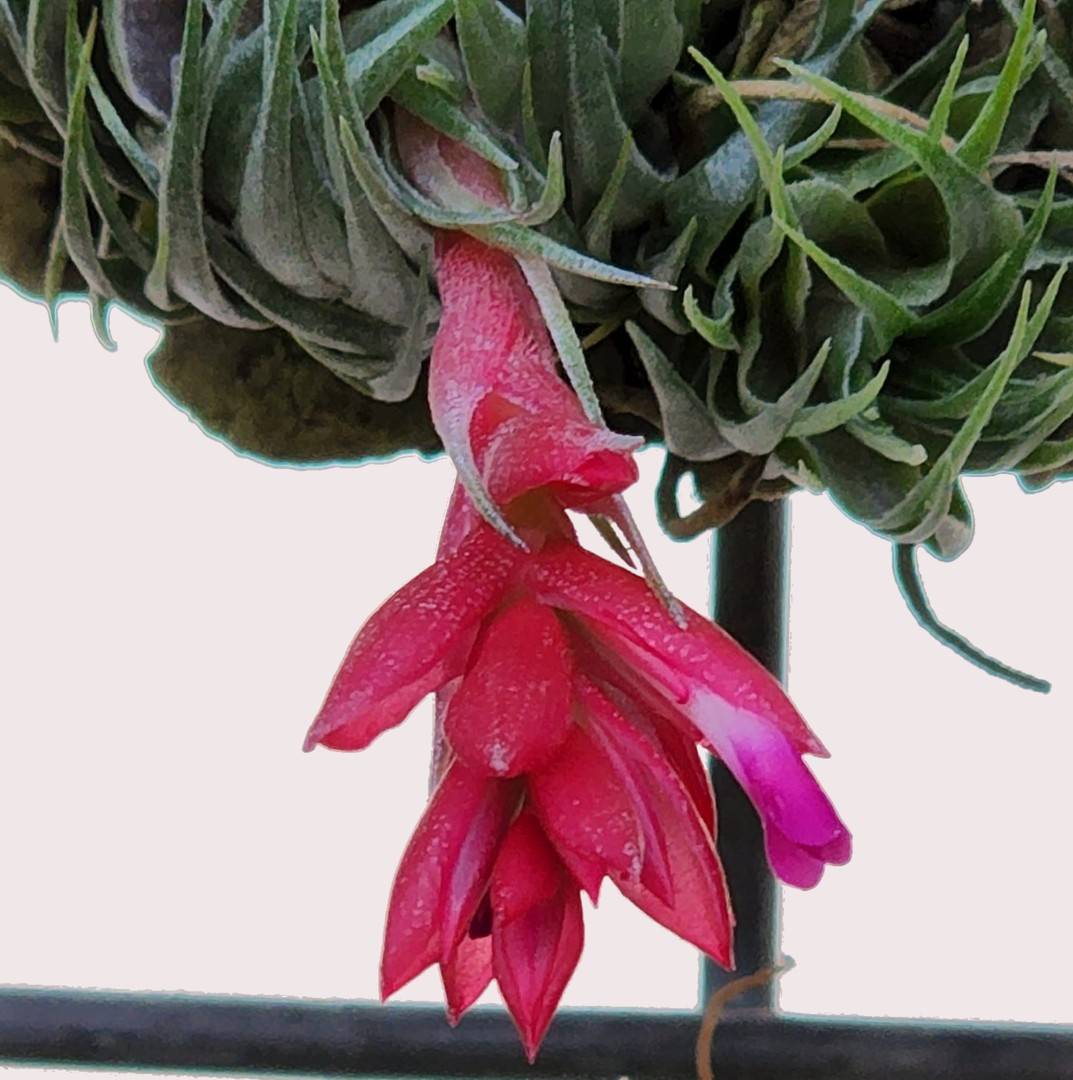
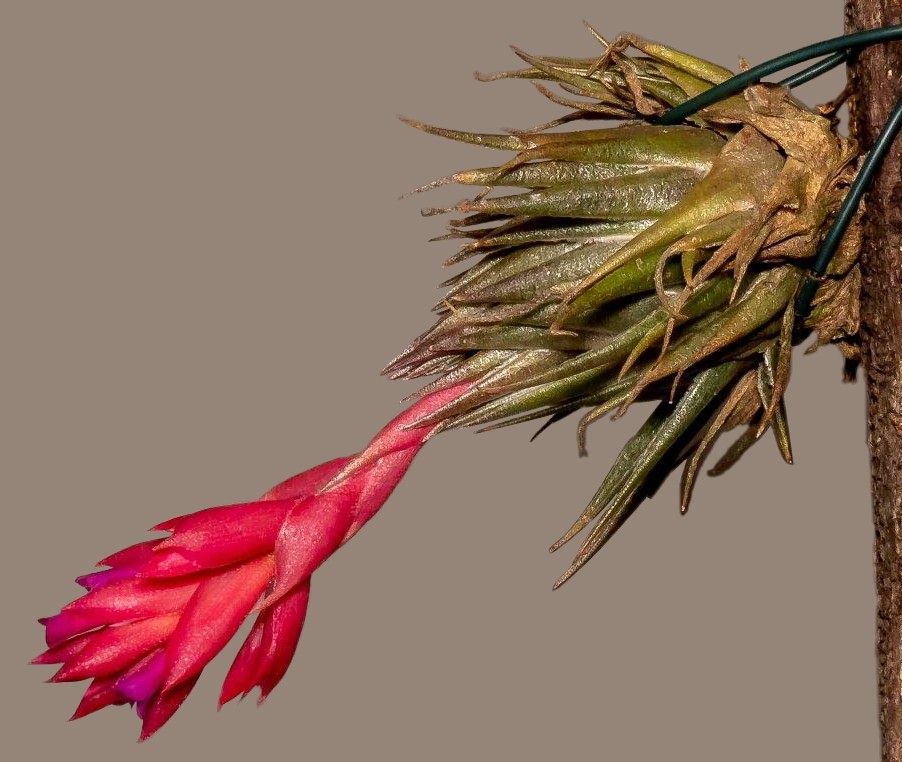
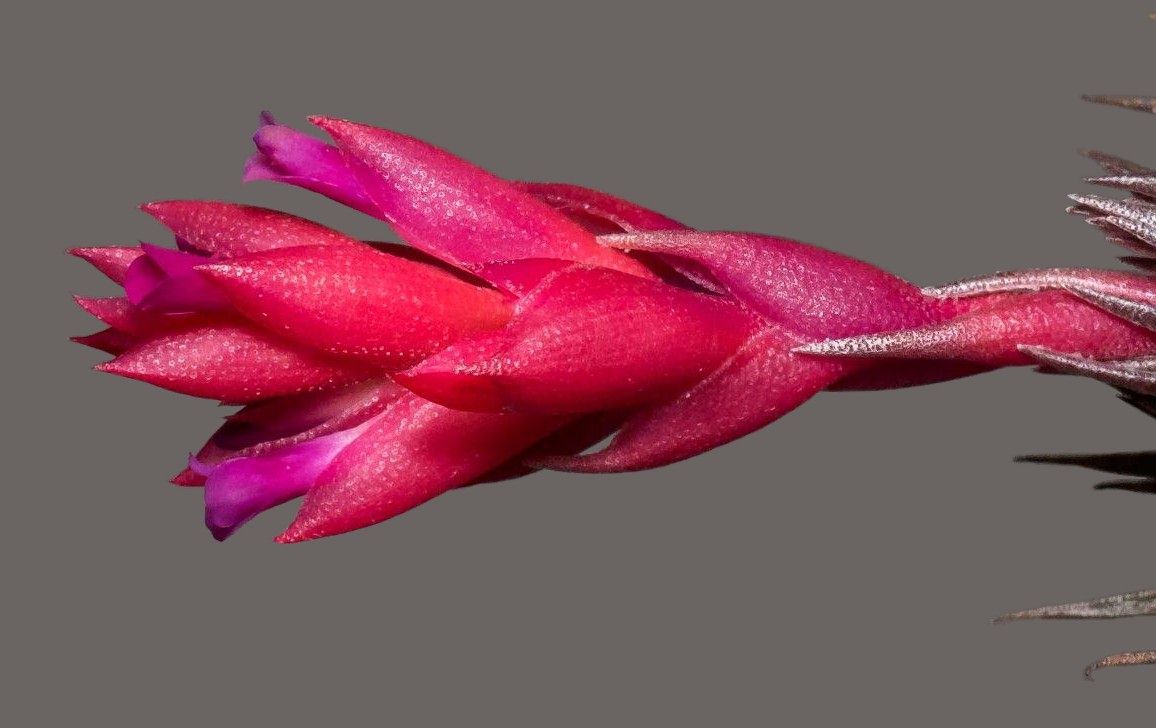

Key to Brazilian Tillandsias, with red or pink petals from Die Bromelie, Sonderheft 3 1996
1. Stamens - exceeding the flower tube => paraensis
- included in the flower tube => 2
2. Leaf blade - filiform and grasslike => globosa
- triangular => 3
3. Plant - 4 - 8 cm in diameter => 8
- 10 - 25 cm in diameter, forming a more or less spreading rosette, stemless => 4
4. Floral bracts - lepidote => 5
- glabrous or nearly so: Plant 6 - 15 cm diameter, inflorescence elliptic or globose, spikes elliptic, sublax with 1 - 3 (- 5) flowers, floral bracts carinate, glabrous or punctulate lepidote, sepals glabrous => roseiflora
5. Inflorescence - elliptic or subglobose => 6
- elongate => 7
6. Leaves - soft, green or reddish, appressed lepidote, spike lax, 2 - 4 flowered, floral bracts shorter than sepals, petals red - violet => geminiflora
- soft, grey, densely lepidote with spreading trichomes, spikes dense, 3 - 12 flowered, floral bracts densely lepidote, exceeding the lepidote sepals => gardneri
7. Leaves - subsucculent, stiff, inflorescence with 4 - 6 spikes => chapeuensis
- Plant only 11 - 13 cm in diameter, an open silvery star-shaped rosette, leaves appressed lepidote, inflorescence with 5 - 7 spikes => grazielae
8. Plant - short - caulescent => 9
- stemless, forming an erect, often subbulbose rosette, leaves often somewhat secund, inflorescence elliptic or subglobose, flowers red or violet, filament not plicate => 10
9. Plant - 3 to 5 cm in diameter, pine cone shaped, dorsiventral, pendant, leaves green, silvery appressed lepidote, inflorescence simple, distichous => reclinata
- 4 to 8 cm in diameter, an erect-secund rosette, the basal leaves recurved, leaves cinereous-lepidote, inflorescence compound, spikes lax, floral bracts carinate, shorter than the lepidote sepals, the posterior ones carinate and 4 mm connate => sucrei
10. Floral bracts - glabrous or nearly so => 14
- lepidote => 11
11. Inflorescence - simple => 12
- bipinnate: Leaves channelled, regularly lepidote with coarse cinereous scales, inflorescence with up to 8 spikes which are laxly 3 - 4 flowered, the posterior sepals carinate, 1/3 to 1/2 connate, lithophytic growing at sea level => brachyphylla
12. Inflorescence - with polystichous flowers => 13
- with distichous flowers: Plant ca. 4 cm in diameter, short caulescent, small pine cone shaped, pendant, leaves grey appressed lepidote => reclinata
13. Leaves - secund, thin and soft, grey with appressed trichomes, looking like grey velvet, scape densely lepidote, inflorescence simple, sometimes compound of up to 3-flowered spikes, floral bracts carmine-red, sepals slightly lepidote, free, posterior ones carinate, petals violet-rose => heubergeri
- Leaves not secund, subsucculent, green, covered with coarse grey scales, plant pendant, floral bracts rose, sepals more lepidote, petals pink => thiekenii
14. Posterior sepals - not carinate => 15
- carinate => 16
15. Leaves many, green-grey, densely lepidote with irregular cumulated coarse trichomes, appearing rough pruinose, epiphytic at sea level => sprengeliana
- Leaves many, narrow triangular, with appressed trichomes, appearing metallic, epiphytic 700 - 1000 m => kautskyi
16. Plant - 2.5 to 5 cm in diameter, rosette of broadly triangular leaves with shorter blade, very densely and regularly silvery subpruinose lepidote, appearing like silvery velvet, sepals carinate and short connate, lithophytic 1800 - 2200 m => organensis
- Plant bigger, up to 15 cm in diameter, rosette often bulbose, leaves grey - green appressed grey lepidote, appearing like grey velvet, bipinnate with 1 - 3 (-5 ) flowered spikes, floral bracts conspicuously carinate, posterior sepals carinate, epiphytic => roseiflora